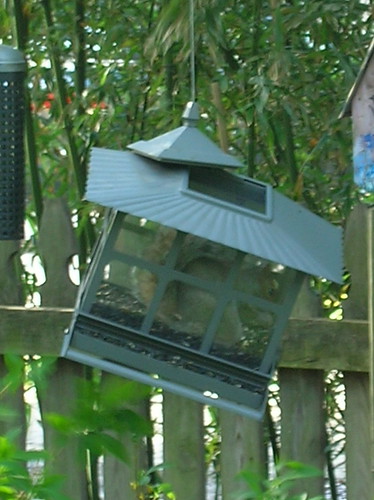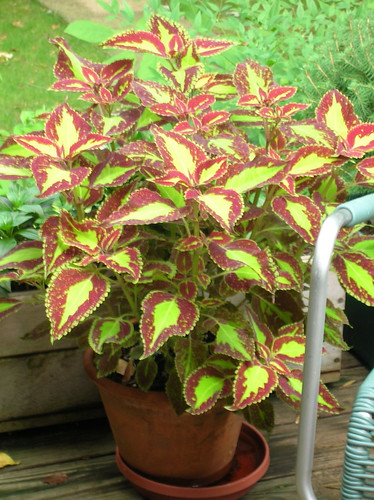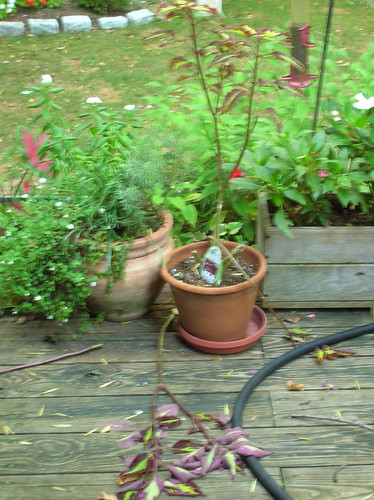 All summer I watched our fig tree with baited anticipation. I adore figs and our nascent tree, though grown in a pot and only in its first year, was vigorous and healthy. With it, the promise of fresh-from the-tree-figs, budding heartily on its stems, tantalized me everytime I spied it by the back deck. It only had about five fruits, but I watched them ripen in painstaking slowness over August and then into September, peering at the fruits, practically drooling as as they slowly turned from bright green to deep brown.
All summer I watched our fig tree with baited anticipation. I adore figs and our nascent tree, though grown in a pot and only in its first year, was vigorous and healthy. With it, the promise of fresh-from the-tree-figs, budding heartily on its stems, tantalized me everytime I spied it by the back deck. It only had about five fruits, but I watched them ripen in painstaking slowness over August and then into September, peering at the fruits, practically drooling as as they slowly turned from bright green to deep brown.All summer, we have also been plagued by drought-like conditions and by several crazy squirrels. I grew up hearing my mother curse the squirrels that dug up her garden and which would climb in through our chimney and run in the space between the walls on winter mornings, their scampering claws on the eaves above my head a six a.m. wake-up call. Now, a couple decades later, I am once again plagued by a crazy squirrel: one afternoon I watched as it literally turned flips in some sort of hyper-active fit. It systematically chewed the coleus plant, chewing one stalk each day until the plant was completely stripped. We've invested in several "squirrel proof" birdfeeders, only to find the squirrel has dismantled them, sending them smashing to the ground, and even prying the top off of them and climbing inside to feast glutinously in a sea of sunflower seeds.




"Squirrel-Proof" Bird Feeders, Coleus Plant Before and After
When watering our plants one day, I noticed our figs were ready: ripe, plump, brown figs!! A few hours later I returned, only to find a cruel surprise: the tree bore no hint of fruit. It seems the squirrel had beat me to it, stripping the tree and devouring its luscious fruits leaving not even a nubby stem behind. To say I was devastated would be an exaggeration, but I was truly saddened that I wouldn't get to taste the fruits of a long, hot summer's labor.

Determined to turn our fig tree into some sort of gustatory pleasure, I remembered a recipe that called for salmon wrapped in fig leaves. Wrapping fish in leaves, like grape leaves or chard leaves, is a common Mediterranean practice but using fig leaves is unusual because they are rather tough and inedible. I first read about the recipe in that lovely children's book Fanny at Chez Panisse, and if you remember a recipe you heard about when you were seven, it ought to be worth making. The salmon fillet at the shop was beautiful and I added a dose of lemon for good measure and wrapped it in the fig leaves, adding some beet greens on top to keep the unwieldy leaves in place.
As the fish roasted, the house started to fill with the most amazing aroma: the smell of coconut. Fig leaves, when cooked, give off the most tantalizing coconut-like smell, I wouldn't have been surprised if my neighbors had come knocking on my door in search of the glorious source. Thankfully, none did, because I don't think we would have wanted to share, the fish was knock-out good. Of course, a lovely fillet of salmon perfectly roasted is bound to be good, but I can't help think that coconutty fig leaf aroma had a lot to do with the magic. If you don't have access to fig leaves (and I am afraid of stripping our baby tree any further), give it a try with hearty leaves like beet or chard, it will still be delicious. And in the battle of me versus squirrel, the squirrel might still be ahead but I've got one very happy victory under my belt.

Salmon Roasted in Fig Leaves
Fig leaves give off the most amazing coconut-like smell when roasted, but if you don't have them substitute a firm leaf like beet, turnip, or chard greens. Serves 6. Adapted from The Chez Panisse Cafe Cookbook.
12 large fig leaves, or beet greens or chard
2 to 2 1/2 lb fillet of salmon
1 lemon
coarse salt, olive oil
1. Preheat the oven 400 F. Lightly oil a large casserole. Wash the leaves well and place enough fig leaves shiny-side up to cover the bottom of the dish. Place the salmon fillet over top. Grate a little of the lemon zest directly onto the salmon, then halve the lemon and squeeze half the juice over the fish. Sprinkle with salt. Fold the leaves up around the salmon fillet, and place several more leaves over top to hold the leaves in place. If your leaves are uncooperative, you can try and tie them in place with a bit of kitchen twine. Drizzle some olive oil over the outside of the fig leaves. Place in the oven and roast for 20-25 minutes, or until fragrant and the fish is plump.
For a fancier presentation: Cut the fillet into serving size pieces. Wrap each piece in a fig leaf and tie with twine to secure (it's ok if the fish isn't completely covered). Roast 15 minutes.
_________________________________

Something I have read repeatedly is if you have critters eating your garden fruits (tomatoes they love), provide bowls of water. I am sure the squirrels knew how desirable figs are but then again they may have just been thirsty!
ReplyDeleteSorry for your loss though, I know my dogs eat my tomatoes, raspberries and blackberries! And they have water!
I've never tried anything like that. I too got no figs this year (because I trimmed too late).
ReplyDeleteI use the clean leaves when I make cheese plates and as a general decoration when entertaining.
I never thought about using them for fish but it makes complete sense!
Anon- We have a bowl of water out for the dog, and bird-baths, so I'm afraid I'm up against something more severe. I've never heard of a dog eating your tomatoes though, how annoying. I'm afraid the squirrel battle continues...
ReplyDeleteCybele- that's a lovely idea for the cheese plate, thanks!
What a sad story! But way to make the best of it - it looks like a delicious recipe!
ReplyDeleteHa, I love the description you put on tastespotting!
ReplyDeleteDratted squirrels. I've always thought they were kind of cute until this past year when I realized that they're just rodents with bushy tales. They can be so destructive that it's hard not to detest them.
ReplyDeleteBest of luck with your figs next time around. I just had some the other night with greek yogurt and a little honey drizzled on top...but alas, they came from a New York City grocery store, not my very own tree!
lol! I am so sorry about your figs, Mercedes! I never knew that fig leaves had a coconut aroma when baked. We would have to bake a coconut cake for dessert here to satisfy the craving that would cause ;) Love, Q
ReplyDeleteThanks for the compassion everyone!
ReplyDeleteJulai- agreed, they're really rodents, did you see that article in Sunday's NYTimes?
And figs and yogurt, yum!
Quinne- I know, I was surprised also! My mom's favorite dessert is coconut cake, so I better not make this dish for her, lest I have to make a cake too!
Dear Mercedes,
ReplyDeleteI have a 7 year old fig tree that gives lots and lots of beautiful figs. I have been looking around for a good recipe for pickled figs. I remember from your posts how much you like figs and thought maybe you knew a recipe to recommend?
:s